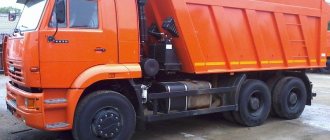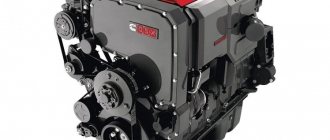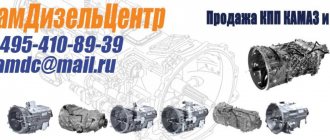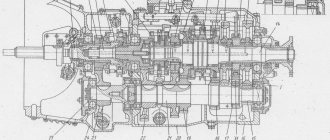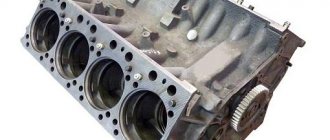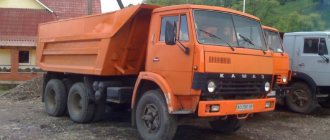About the history of the KamAZ-6520 model
KamAZ-6520 dump trucks are one of those main families of the Kama Automobile Plant, which allow the company to confidently maintain a leading position in the truck market in the CIS. Being designed for the transportation of bulk construction, agricultural and industrial cargo on roads with an axle load limit of 10-13 tons, this particular vehicle more than ten years ago became the very first heavy-duty dump truck in the KamAZ plant product line.
Until the beginning of the 2000s, the most powerful dump trucks produced at the Kama Automobile Plant were the KamAZ-55111 with a carrying capacity of 13 tons, as well as the heavier KamAZ-65115, with a carrying capacity of 15 tons. But at the beginning of the new century, a real grandiose “construction boom” unfolded in the country, and the capabilities of these machines were not always sufficient for the growing needs of the booming construction industry.
Therefore, in just a few years, a new model of a dump truck with a 20-ton payload was quickly developed. This vehicle, designed for large-scale construction, quarrying and agricultural work (grain trucks), having a load capacity of up to 20 tons, has become the most powerful dump truck in the vehicle line. Its serial production started in 2003.
An important point: KamAZ-6520 was not a modernization of dump trucks previously produced by the company, or a copy of any of the trucks from other manufacturers. This is a completely new model, developed from scratch.
What's under his cabin?
Engines "KAMAZ-6520"
KamAZ-6520 dump trucks of the first years of production were equipped with KamAZ-740.51-320 diesel engines with a turbocharging system. This version of the classic KamAZ power unit was developed in the early 1990s, and was also used for other families of Kama trucks. The power of this engine is 320 horsepower, compliance with the environmental standard - Euro-2.
Since 2009, the company began equipping KamAZ-6520 dump trucks with new KamAZ-740.63-400 engines that already meet the Euro-3 standard. This V-shaped 8-cylinder engine has greater performance than its predecessor. Its characteristics are as follows: displacement – 11.76 liters, rated power – 400 horsepower, maximum torque – 1766 Nm, compression ratio – 16.5. A turbocharging system is also present.
Since 2008, some KamAZ-6520 vehicles also began to be equipped with Cummins ISLe +350 engines. The Cummins power unit generally shows better efficiency indicators than the KamAZ-740 engine. Characteristics of the Cummins ISLe +350 engine: displacement - 8.9 liters, rated power - 334 hp, maximum torque - 2738 Nm, environmental class - Euro-3.
Engine "KAMAZ-740.73-400" under the cab of the truck.
Currently, KamAZ-6520 dump trucks are equipped with new KamAZ-740.73-400 (Euro-4) engines. This is an 8-cylinder V-shaped diesel engine with turbocharging and intercooling of charge air, equipped with a progressive Common Rail fuel supply system. The maximum net power of the KamAZ-740.73-400 is 294 kW (400 hp), at a crankshaft speed of 1900 rpm.
The maximum useful torque is 1766 Nm (180 kgcm), at a crankshaft speed of 1250 -1350 rpm. The working volume is the same as the previous version – 11.76 liters. Cylinder diameter – 120 mm, piston stroke – 130 mm Compression ratio is 17.9. The engine is equipped with a pre-start heater “PZhD 15.8106-01”. The capacity of KamAZ-6520 fuel tanks is 350 liters. The traction and dynamic parameters of the engine and the dump truck itself allow the truck to easily overcome 25% inclines when the loading platform is fully loaded.
TRUCKS GAZ, ZIL, KAMAZ, URAL, MAZ, KRAZ
_________________________________________________________________________________________
Maintenance of ZF gearbox for 16 Kamaz-6520 vehicles
The sixteen-speed gearbox of the ZF 16s151 Kamaz gearbox is installed on the chassis, dump trucks, and long-haul vehicles Kamaz-6350, 6450, 6520, 65221, 65225, 5460 of the heavy family. The ZF-16 gearbox consists of the following main components: a main four-stage gearbox, a front two-stage gear divider and a range-multiplier. All forward gears in the main gearbox are activated by synchronizers, and the reverse gear is engaged by a gear clutch. The highest gear is overdrive. The ZF 16s151 planetary gearbox multiplier is automatically switched using a pneumatic valve by a synchronizer when the lever is moved in neutral from the 3-4 gear position to 5-6 and vice versa. The gear divider of the ZF-16 Kamaz-6520 gearbox is mechanical, consisting of two pairs of cylindrical gears and a synchronizer. The divider control is pneumatic. The weight of the gearbox is 290 kg. Maximum torque 1850 N/m.
Rice. 1. Connection diagram for the pneumatic control of the ZF 16 Kamaz-6520 gearbox for the divider and range 1 - clutch reservoir; 2 — clutch pedal; 3 — gear shift lever; 4 — reverse sensor; 5 — valve for switching on the range multiplier; b — neutral sensor; 7 — sensor for switching on the low range of the range multiplier; 8 — range switching cylinder; 9 — first gear sensor; 10 — air distributor of the divider; 11 — sensor for switching on the low range of the divider; 12 — top gear engagement sensor; 13 - to the clutch slave cylinder; 14 — valve for switching on the divider; 15 — clutch master cylinder. The ZF-16s151 gearbox consists of the following main components: a main four-stage gearbox, a front two-stage gear divider and a range-multiplier. All forward gears in the main gearbox are activated by synchronizers, and the reverse gear is engaged by a gear clutch. The ZF 16 Kamaz-6520 gearbox multiplier is planetary, it is automatically switched using a pneumatic valve by a clutch synchronizer when the lever is moved in neutral from the 3-4 gear position to 5-6 and vice versa. The gear divider for the ZF-16 Kamaz gearbox is mechanical and consists of one pair of spur gears and a synchronizer. The divider control is pneumatic. The ZF 16s151 gearbox is engaged mechanically, through double engagement. It is divided into 5 tracks located next to each other. On tracks 3-4 or 5-6 the lever is in neutral position. Spring clamps of the ZF 16 Kamaz-6520 gearbox constantly press the lever to the neutral position. Pneumatic switching of the range multiplier occurs automatically when the lever is moved in neutral from the 3-4 gear position to 5-6 and vice versa. Preliminary gear selection in the divider is made by moving the pneumatic valve switch installed in the gear shift lever handle in one of the positions. The gear in the ZF 16 Kamaz gearbox divider switches after pressing the clutch pedal. Depending on the conditions of use of the vehicle, you can use a divider in any gear. The ZF 16 Kamaz gearbox servo amplifier consists of a control unit and a two-position cylinder. The gears in the gearbox are engaged as described above, only with pneumatic assistance. Advantage: Reduced gear shifting effort. Prolonged engagement of gears with high manual force contributes to increased wear of the synchronizers. The Kamaz gearbox ZF-16, depending on the vehicle model, can be equipped with a power take-off. Problems when changing range positions (for example, tracks 3-4 gears to 5-6 gears or vice versa) can have the following reasons: - damage to the pneumatic system. — The switching valve or the switching cylinder of the range multiplier has defects (condensation or contamination). Continuation of movement is possible only when the lowest range of the multiplier is turned on (gears 1-4). If the direct range gear remains engaged, the vehicle can be towed. Operation of a Kamaz vehicle with a ZF gearbox at low temperatures. The ZF-16 Kamaz gearbox is filled with oil according to the chemical chart. The gearbox can operate at external temperatures down to -30°C. The following points must be taken into account: - at external temperatures down to -20°C - after starting the engine, a period is required to warm up the gearbox. Warming up of the transmission oil should be carried out with partial (incomplete) load at low speed. - at external temperatures down to -30°C - before starting the engine, it is necessary to warm up the gearbox with warm air. You should also pay attention to the fact that the temperature in the gearbox should not exceed 150°C. To guarantee the long service life and functionality of the synchronizers, the clutch must function perfectly. Clutch operation should be checked as follows: — At idle engine speed, depress the clutch; - No more than 20 seconds. slowly engage reverse gear). If “grinding” of the gear couplings is noticed, it is necessary to adjust the clutch or check it. Before the ZF-16 KamAZ gearbox divider is engaged through the shut-off valve, the clutch must be completely open. If the shut-off valve is installed incorrectly, there is a risk of destruction of the synchronizer when changing gears of the divider. Checking the clutch of a Kamaz vehicle for the ZF-16 gearbox - Adjust the clutch - Install the adjusting screw on the clutch pedal so that the valve opens and closes in the area. — In position, the clutch is completely open. In this position of the pedal, the gap between the valve and the stop screw must be at least 1 mm. Maintenance of the pneumatic installation of the ZF 16 gearbox Condensation moisture is formed in each pneumatic installation. To prevent condensation and rust from getting from the receiver into the valves and pneumatic cylinders, regular inspection of the pneumatic system is necessary. The receiver must be dehydrated weekly, and daily in winter. Along with the receivers, moisture must also be removed from the filters using a water separator, if it does not work automatically. Transmission equipment ZF 16 Gearbox designation - ZF 16s151 Specification number - 1341.002.073/1341.002.074 Flange - end splines 1297.333.110 Rear bearing cover of the input shaft, clutch housing, lever and fork (if not serial) - 1315.302.136 cover, 1315.368 .025 fork, 1316.301.064 crankcase Gearbox primary shaft (splines) and secondary shaft - 1315.302.153 SAE10C 2" 1315.304.131 Secondary shaft rear bearing cover assembly and part - 1315.231.004, 1315.301.220 Note - standard execution.
_________________________________________________________________________________________
- GAZ-3307 clutch maintenance
- Steering system GAZ-3307
- Gearbox parts for GAZ-3307
- Maintenance of the rear axle GAZ-3307
- Maintenance of the fuel system of the D-245 diesel engine
- Clutch GAZ-3309 with a diesel engine
- Operations for disassembling the GAZ-3309 gearbox
- GAZ-3309 front axle service
- Repair of cardan shafts of GAZ-3309 cars
_________________________________________________________________________________________
_________________________________________________________________________________________
- Operations for assembling basic components of the ZIL-130 engine
- Service and repair operations for the ZIL-130 gearbox
- Maintenance and repair of ZIL-130 clutch
- Repair and adjustment of the rear axle ZIL-130
_________________________________________________________________________________________
- KAMAZ-4310, 43118, 43114
- KAMAZ-5320, 55111, 53212, 5511, 55102
- KAMAZ-65115, 6520, 65117
- KAMAZ-4308
- Engine KAMAZ-740
_________________________________________________________________________________________
- Parts of the cylinder block and head of the YaMZ-236 engine
- Service maintenance of the YaMZ-236 piston group and crankshaft
- Diagnostics and technical adjustments of the YaMZ-236 engine
- Design and adjustment of fuel injection pump and injectors of the YaMZ-236 engine
- Cylinder block and piston YaMZ-238
- Components of the YaMZ-238 diesel fuel supply system
- Design and adjustment of the fuel injection pump of the YaMZ-238 diesel engine
- Technical design of the YaMZ-239 gearbox
_________________________________________________________________________________________
- Components of the front axle and steering rods of the Maz-5516, 5440
- Steering system of Maz-5516, 5440 cars
- Clutch and gearbox parts Maz-5516, 5440
- Maintenance of drive axles of MAZ-5516, 5440 vehicles
- Power steering for Maz-5551, 5335 cars
- Maintenance of cardan transmission of Maz-5551, 5335 cars
- Maintenance and adjustment of clutch MAZ-5551, 5335
- Repair and service of the rear axle of MAZ-5551, 5335 cars
_________________________________________________________________________________________
- Gearbox Ural-4320
- Construction and adjustment of Ural-4320 bridges
- Maintenance of transfer case Ural-4320
- Steering components Ural-4320
_________________________________________________________________________________________
- Servicing the KRAZ-255, 260 gearbox
- Steering mechanism and power steering Kraz-255, 260
- Adjustments and repairs of the power steering cylinder and steering rods of the Kraz car
- Drive axle components and drive shafts Kraz-255, 260
Transmission "KAMAZ-6520"
The clutch is installed diaphragm, single-disc type. Drive – hydraulic, with pneumatic booster. The gearbox currently installed on the KamAZ-6520 is “ZF-16S1820” - mechanical, sixteen-speed. The gear ratio of the double final drive gearbox is 5.11.
By the way, the “pre-restyling” KamAZ-6520 cars were also equipped with a modern imported gearbox, also only an eight-speed one: “ZF-8S1820”. However, now these manual transmissions are already “only half” imported, since they are produced under license from a German company at a plant in Naberezhnye Chelny.
The KamAZ-6520 transmission provides the vehicle with high traction and dynamic performance with a relatively low level of fuel consumption: 40-55 liters per 100 km (depending on the type of engine installed and operating conditions). This model is also equipped with lockable cross-wheel and center differentials and a modern ABS system.
Switching the ZF gearbox on Kamaz vehicles
The switching pattern for the ZF Ecomid and Ecosplit gearboxes on KAMAZ trucks is the so-called “double H”. Those. There is a low (S) and high (L) gear range. Each range has four basic gears, which are expanded by a divider and a multiplier. The return of the lever to “neutral” after switching off the gear occurs automatically due to the fact that the lever is pressed into the neutral position by spring clamps. The multiplier from L range (row 3/4) to S (row 5/6) and back also switches automatically by supplying air under pressure to the working cylinder. You can engage a new gear only after the previous shifting process has been completed. Reverse and low gear (C) are only available in the low (S) range of the multiplier. Engaging these gears requires little effort, because... There is a safety spring installed there, which eliminates the possibility of accidentally selecting one of these gears.
Gear shifting on ZF Ecomid
Gear shifting on ZF Ecosplit
Recommendations for shifting gears
- The gearshift lever should be moved smoothly, without jerking or unnecessary effort, with your hand unclenched.
- When you engage a gear, hold the lever while the synchronizer makes the shift.
- In order to switch from track 3-4 to 5-6 and vice versa, you need to make a short push in the desired direction and then smoothly engage the desired gear.
- If the car is slowing down, it is recommended to change gears in reverse order sequentially or in a maximum of two stages.
- The car should always move with the gear engaged. This is especially true when coasting on a descent.
- When switching from high to low range, the speed should be less than 30 km/h.
- Engage reverse gear only when the car is stationary.
Steering and brake control, electrical equipment
The KamAZ-6520 steering mechanism is equipped with power steering and a hydraulic rotation limiter, which prevents damage to the steering rods. This dump truck is also equipped with a safety steering wheel.
Brakes – with pneumatic drive. Dimensions: drum diameter – 420 mm; Brake lining width – 180 mm.
"KAMAZ-6520" with a U-shaped body.
The internal network voltage is 24 Volts. There are two batteries, 12 Volts / 190 Ampere Hours each. Generator – 28 V / 2000 W
Not available:
| № | Part code | Name | Part Information |
| 1315307305 | Stop sheet | Quantity 1 Group Cooling system Subgroup 1315 Part number 307 | Not available |
| 730063273 | Sleeve | Quantity 1 Group Triple seat Subgroup Triple seat assembly Serial part number 632 Additionally Not interchangeable with a part previously released under the same number | Not available |
| 1315307111 | Stop sheet | Quantity 1 Group Cooling system Subgroup 1315 Serial part number 307 Additionally Not interchangeable with a part previously released under the same number | Not available |
| 1315307202 | Hollow shaft | Quantity 1 Group Cooling system Subgroup 1315 Part number 307 | Not available |
| 631329117 | Adjustable cotter pin | Quantity 1 Group Tailgate Subgroup Tailgate windshield wiper Sequential part number 291 Additionally Not interchangeable with a part previously released under the same number | Not available |
| 631306832 | Cylindrical cotter pin | Quantity 4 Group Tailgate Subgroup Tailgate windshield wiper Sequential part number 068 Additionally Not interchangeable with a part previously released under the same number | Not available |
| 1315307203 | Lock lever | Quantity 2 Group Cooling system Subgroup 1315 Part number 307 | Not available |
| 635303053 | Needle bushing | Quantity 1 Group Tailgate Subgroup 6353 Serial part number 030 Additionally Not interchangeable with a part previously released under the same number | Not available |
| 1315307197 | Gear shift housing | Quantity 1 Group Cooling system Subgroup 1315 Serial part number 307 Additionally Not interchangeable with a part previously released under the same number | Not available |
| 736010203 | Bolt | Quantity 10 Group Triple seat Subgroup 7360 Serial part number 102 Additionally Not interchangeable with a part previously released under the same number | Not available |
| 636015321 | Bolt | Quantity 7 Group Tailgate Subgroup 6360 Serial part number 153 Additionally Not interchangeable with a part previously released under the same number | Not available |
| 630001075 | Washer | Quantity 7 Group Tailgate Subgroup Tailgate assembly Serial part number 010 Additionally Not interchangeable with a part previously released under the same number | Not available |
| 1315307314 | Lid | Quantity 1 Group Cooling system Subgroup 1315 Serial part number 307 Additionally Not interchangeable with a part previously released under the same number | Not available |
| 1315307201 | Pad | Quantity 1 Group Cooling system Subgroup 1315 Part number 307 | Not available |
| 1315307019 | Cork | Quantity 2 Group Cooling system Subgroup 1315 Serial part number 307 Additionally Not interchangeable with a part previously released under the same number | Not available |
| 730009515 | Sealing ring | Quantity 2 Group Triple seat Subgroup Triple seat assembly Serial part number 095 Additionally Not interchangeable with a part previously released under the same number | Not available |
| 732041612 | Compression spring | Quantity 2 Group Triple seat Subgroup 7320 Serial part number 416 Additionally Not interchangeable with a part previously released under the same number | Not available |
| 636302045 | Threaded plug | Quantity 1 Group Tailgate Subgroup 6363 Serial part number 020 Additionally Not interchangeable with a part previously released under the same number | Not available |
| 730009515 | Sealing ring | Quantity 1 Group Three-seater seat Subgroup Three-seater seat assembly Serial part number 095 Additionally Not interchangeable with a part previously released under the same number | Not available |
| 630532130 | V-ring | Quantity 1 Group Tailgate Subgroup Lock and handle Part number 321 | Not available |
| 501209212 | Stopper | Quantity 1 Group Cabin (Body) Subgroup 5012 Serial part number 092 Additionally Not interchangeable with a part previously released under the same number | Not available |
| 1315307230 | Shift lever shaft | Quantity 1 Group Cooling system Subgroup 1315 Serial part number 307 Additionally Not interchangeable with a part previously released under the same number | Not available |
| 730260330 | Split bushing | Quantity 1 Group Triple seat Subgroup 7302 Serial part number 603 | Not available |
| 1315307013 | Pad | Quantity 1 Group Cooling system Subgroup 1315 Serial part number 307 Additionally Not interchangeable with a part previously released under the same number | Not available |
| 1315307092 | Leash | Quantity 1 Note interchangeable Group Cooling system Subgroup 1315 Serial part number 307 Additionally Not interchangeable with a part previously released under the same number | Not available |
| 1315307188 | Leash | Quantity 1 Note interchangeable Group Cooling system Subgroup 1315 Serial part number 307 Additionally Not interchangeable with a part previously released under the same number | Not available |
| 631329073 | Adjustable cotter pin | Quantity 2 Group Tailgate Subgroup Tailgate windshield wiper Serial part number 290 Additionally Not interchangeable with a part previously released under the same number | Not available |
| 631329101 | Adjustable cotter pin | Quantity 2 Group Tailgate Subgroup Tailgate windshield wiper Sequential part number 291 Additionally Not interchangeable with a part previously released under the same number | Not available |
| 1315307308 | Locking part | Quantity 1 Group Cooling system Subgroup 1315 Part number 307 | Not available |
Frame, cargo platform, suspension and chassis "KAMAZ-6520"
To achieve higher load capacity, power and efficiency than its predecessors, KamAZ-6520 acquired completely new modern hydraulics, a reinforced frame and a number of units not only of domestic but also foreign production. For example, many cars were produced with Hungarian drive axles.
The KamAZ 20-ton truck is equipped with a hydraulic tipping device driven by a power take-off, a powerful subframe and a body stop. The loading platform is lifted by a hydraulic cylinder of the façade structure, which increases stability during unloading.
The heavy dump truck received an all-metal reinforced welded platform that tilts back. Initially, the body did not have a heating system, but in 2007 this technical solution was implemented. The platform is controlled directly from the driver's cabin. The body is protected by a canopy that covers the space between it and the cabin.
"KAMAZ-6520" is equipped with drive axles with a single-stage main gear and planetary-type wheel reducers. This design not only increases the clearance of the bridge, but also significantly increases the reliability and durability of the bridges, which is especially important when operating a truck with overload.
The durability of the supporting structure is ensured by straight-section frame spars equipped with reinforcements. Transverse stabilizers are installed on the rear axle and front axle, which contribute to greater stability of the heavy truck when cornering and when maneuvering. The cross-axle differential locking mechanism provides a significant increase in the truck's cross-country ability, which makes it suitable for use in off-road conditions too.
Suspension - spring. The wheels are disc mounted, with pneumatic tubeless tires. Rim size – 9.00-22.5. Tire size – 315/80 R22.5.
Rules for shifting gearboxes in different conditions
Knowing how to start and how to continue moving is not enough for the correct operation of the KAMAZ transmission. To avoid problems with the unit when using the gearbox, you must follow the rules. Errors made during operation can lead to serious malfunctions.
On the rise
How to change gears on a KamAZ when driving uphill
Driving a domestic truck when lifting must be done at increased speed. To switch from first to second speed, the driver needs to depress the clutch twice. Consider the fact that you must simultaneously press the gas pedal and the fuel pedal. These actions are important as they help stabilize the overall performance of the crankshaft. To avoid problems with the operation of the unit, you do not need to reduce the engine speed to less than two thousand when climbing. This will cause the car engine to turn off. Also, such driving increases the operating temperature of the power unit, and this can cause its breakdown.
When driving a car using this principle, you can achieve maximum directional stability. Thanks to the principle of dividing the transmission circuit into two modes, easier engine operation is achieved. Moreover, regardless of whether the car is loaded or not.
On the descent
If you are driving downhill, you do not need to turn off the engine. When the engine is turned off, the steering wheel will lock. And this will lead to an emergency on the road. When driving downhill, do not turn off the auxiliary braking, and also depress the clutch pedal all the way. Newer versions of trucks use improved transmissions, which has allowed engineers to reduce the load on the main gearbox parts. Therefore, when driving in critical conditions and on descents, the car’s engine will not wear out.
KamAZ vehicles use a double-boost braking system. That is, in addition to braking by the power unit, there is an additional engine stopping system. If you are driving downhill with active auxiliary braking, then you cannot disengage the clutch and change gears.
Schemes of the main and transfer cases on KamAZ
Icy areas
Driving a truck on icy areas should be done with the greatest reserve of speed and travel. When braking, use the active brake assist system. If emergency braking occurs, the driver must stop the trailer wheels. If you do not take this point into account, you will end up in a skid. It is recommended to slow down with the power unit only in exceptional cases. Because this leads to accelerated engine wear, but the braking distance is significantly reduced. When braking, do not allow the wheels to slip. To avoid this, you need to turn off the reduced speed in time, this will lead to a drop in crankshaft speed.
Skid
When skidding, follow the main rule - do not squeeze the clutch, otherwise this will worsen the situation. During the production of cars, engineers introduced a scheme due to which the car can drive with the greatest power reserve. Thanks to this, you can achieve course stabilization while driving on any road. If a skid occurs while driving, the steering wheel of the car must be turned in its direction. That is, if the car skids to the left, then the steering wheel also turns to the left.
If the truck begins to slip, then you need to stop moving as quickly as possible and immediately disable the differential axle. You can see the switch to turn it off on the dashboard. When the differential axle is disengaged, a corresponding indicator will appear on the instrument panel. After this, the start of movement is carried out at increased speed, from second gear. When you drive through a hard-to-reach section of the road, do not forget to engage the differential (video shot and published by Vladimir Nikonov).
Technical specifications in numbers
- Overall length – 7710…7800 mm; Width – 2500 mm; Height – 3010 mm;
- Wheelbase – 3600 mm;
- Front overhang – 1320 mm;
- The distance between the axles of the rear bogie is 1440 mm;
- Curb weight – 13025…14500 kg;
- Front axle load – 5305…6300 kg; load on the rear bogie – 7720…8200 kg;
- Load capacity – 20000 kg;
- Maximum trailer weight – 20000 kg;
- Gross vehicle weight – 33100 kg;
- Front axle load – 7500 kg; load on the rear bogie – 25600 kg;
- Permissible trailer weight – 20,000 kg;
- The total weight of the road train is 53100 kg;
- The volume of the cargo platform is 12...16...20 cubic meters; the largest volume is in the modification “KAMAZ-6520-23072-63” (“Grain carrier”): 33 cubic meters of cargo.
- The lifting angle of the loading platform is 50 degrees.
New modifications based on KamAZ-6520
The KamAZ-6520 dump truck became the basis for a whole family of trucks belonging to the heavy class. The new design ensured compliance with all current requirements of domestic and foreign legislation. The vehicle's service life before major repairs is 500 thousand kilometers. The first maintenance should be performed after 5500 km, the second after 16500 km.
Over the years of production, about a dozen modifications of the KamAZ-6520 were produced, the differences between which consist in minor design features and configuration options. Currently, the KamAZ-6520-73 modification remains in mass production, in nine configuration options, each of which has its own factory index. But they all have the same engine brand - KamAZ-740.73-400 (Euro-4), with Common Rail; and the manual transmission is also similar - “ZF-16S1820”. In addition to the rectangular and enlarged “grain” body, U-shaped (or, in Russian speaking, “trough-shaped”) bodies are also installed on the KamAZ-6520 chassis.
"KAMAZ-6520-23072-63" grain truck with trailer.
Since the KamAZ-6520 was the first model developed by our vehicle in quite a long time, new specialized trucks were soon created on its basis. So, in addition to the already mentioned “grain” modification “KAMAZ-6520-23072-63” with a 33-cc body, the first domestic four-axle trucks were built on the basis of the KamAZ-6520 chassis. This is a KamAZ-6540 dump truck with an additional steered axle (8x4 drive), capable of transporting up to 18.5 tons of various bulk cargo. This is a four-axle heavyweight (also 8x4) KamAZ-65201, which is capable of carrying up to 25 tons of cargo.
Such specialized machines are in demand wherever there are axle load restrictions. And for operation in the most difficult road conditions - in quarries, off-road, an all-wheel drive three-axle (“6x6”) modification of the dump truck was developed - “KAMAZ-6522”, with a maximum load capacity of 19 tons.
Design and principle of operation of the gearbox
The main components that make up the KamAZ transmission unit:
- Crankcase device. It uses three shafts - primary, secondary and intermediate. Purpose of the gear module: activation of reverse speed.
- Upper protective cover of the gearbox.
- The gear shift mechanism itself (a collapsible device).
- Engine located on the front of the crankcase.
On KamAZ dump trucks, when switching from high speed to low speed, the rocker is not used. This feature of trucks with European standards Euro 2, 3 and 4 implies the use of a special switch and clutch pedal. Switching is done automatically. In accordance with the official description in the technical manual for use and maintenance, the upper position of the selector is necessary for a loaded car, and the lower position for an empty car.
Drawing of the KamAZ 14 transmission design drawing
A more detailed diagram of the gearbox design of KamAZ trucks using the example of model 14:
- Drive shaft.
- Rear bearing element protective cover for drive shaft.
- Adjusting shim.
- Handle rod.
- Protective ring.
- Handle support cover.
- Handle support block.
- Sealing gasket.
- Rod support.
- Spring element.
- Gear shift knob support.
- Module axis with reverse gears.
- Thrust washer.
- Reverse gear module.
- Roller bearing.
- Screw with pin.
- Lock washer.
- Top cover.
- Sealing rubber.
- Rear bearing cover for driven shaft.
- Retaining ring.
- Rear ball bearing element for traction of the driven shaft.
- Adjusting shim.
- The so-called worm connected to the speedometer drive.
- Sealing collar.
- Flange fixing nut.
- Flange for fixing the cardan shaft.
- Cup of the rear bearing device of the intermediate shaft.
- Bearing device cover.
- Roller bearing.
- Thrust washer.
- Sealing rubber.
- Intermediate shaft.
- Crankcase device of the transmission unit.
- Driven shaft.
- Sealing rubber.
- Front bearing cover located on the intermediate shaft.
- Crankcase device of the clutch system.
- Sealing collar.
- Clutch release fork.
- Clutch release fork shaft.
- Clutch system coupling.
Five-speed gearboxes are installed on cars intended for individual use, while trucks belonging to the class of road trains are equipped with ten-speed units. By design, the 10-speed unit is a box with five steps, complemented by a gearbox with a divider. This system provides the ability to use 10 forward speeds and two reverse.
If a model 152 or 154 transmission is installed on a new or old KamAZ, then it has the following differences from older versions:
- the gearbox is equipped with a reinforced synchronizer for the dividing mechanism;
- in such units the splines are more reinforced, and the fastenings of these elements are removed from the gearbox device;
- in newer versions on models 43118, 5320 and others, a different method of attaching the gears of the unit is used;
- The height of the gearbox teeth has been increased.
In a more modernized version of the KamAZ gearbox, the correct procedure for controlling and activating the dividing mechanism is carried out using a pneumatic device.
With divider
By design, the divider consists of the following elements:
- Spool valve. This component is used to control the gearbox and is located on the gear shift lever support. The node can operate in direct or reduced transmission modes.
- Pressure reducing valve. This element is used to extract compressed air coming from the pneumatic mechanism. The valve bleeds the air flow when the pressure in the system is critically high. From the pressure reducing valve, air is supplied to the control valve and the divider activation valve. This scheme allows you to create two circuits simultaneously in the car’s engine control system.
- Dividing mechanism activation valve. This device is designed to supply compressed air to the unit if the driver disengages the clutch. This principle of operation allows you to turn on and off a lower gear in parallel with changing gears on the main transmission.
- Divider gear shift mechanism. The device consists of a piston located in a cylindrical element. The piston rod is connected to a handle located on the mechanism fork shaft. If a compressed air stream enters the gearbox, the piston moves in a certain direction. As a result of the displacement, the operating mode changes.
- Divider air distribution line. This element is used to supply air to the box cylinder.
- Bearing elements, synchronizers and a crankcase equipped with shafts with gears.
Transmission unit with dividing mechanism
The device of a gearbox with a divider includes the following elements:
- Nut M12x1.25-6N.
- Lock washer marking 12.3.
- Protective cover for the front bearing device located on the intermediate shaft.
- Lock washer for 10.
- Screw M10x1.25.
- Protective cover of the front bearing device located on the input shaft, assembled.
- Seal rubber for the input shaft cover.
- Adjusting shim.
- Adjusting shim.
- Primary shaft of the dividing device assembly.
- Special nut M52x2-L-6N.
- Oil injection ring located on the input shaft.
- Pin class 4x12.
- A radial-type roller bearing device with elongated double-row cylindrical rollers is not equipped with rings.
- Retaining ring.
- The roller bearing device is of radial type and belongs to the category of single-row devices.
- Primary shaft of the transmission dividing mechanism.
- Parallel key.
- Rear bearing element bushing located on the input shaft.
- Gear of the input shaft of the transmission dividing device assembly.
- Drain plug equipped with a magnet to attract wear debris.
- Divider crankcase assembly with bushings assembled.
- Oil can.
- Eye bolt.
- Stub.
- Sealing rubber.
- Screw M8-6gx16.
- Spring washer.
- Hatch cover of the crankcase divider device.
- Crankcase stud M16x1.
- Spring washer.
- Nut standard M16.
- Synchronizer unit for the gearbox dividing mechanism assembly.
- Gasket for crankcase divider device.
- Intermediate shaft.
- The socket of the rear bearing device located on the intermediate shaft.
- Bolt M6.
- Roller bearing element.
- Clutch housing cover located on top.
- Intermediate shaft of the dividing device.
- Intermediate shaft gear.
- Dividing unit of the box with control mechanism assembly.
- Pin 12x35.
- M16 hairpin.
- Radial-type ball bearing element belonging to the single-row class. The device is equipped with a groove and is located on the outer ring.
- Front bearing thrust ring.
- Thrust washer.
- Hairpin M12x1.
- Retaining bar.
- Screw M12x1.25.
- Gasket for the front bearing element cover located on the intermediate shaft.
- Bearing cap seal ring.
- Protective cover for the inspection hole located at the bottom.
- Clutch housing cover.
The main feature of transmissions on KamAZ Euro 2, 3 and 4 is the ability to operate in high or low mode. This feature was provided by the developers to minimize the load on the engine of the machine, which can move both unloaded and loaded. The dividing device is a mechanical gear unit designed to increase the gear ratio.
Transmission diagrams
The following gearboxes are used on KamAZ vehicles today:
- model 14;
- Model 15 transmissions;
- Checkpoint 161;
- ZF transmissions manufactured in Germany.
Model 14
Gearbox Features:
- cars operating “mechanically” of the new model 14 have modifications 141, 142 and 144;
- such systems belong to the category of five-speed units in which three-code switching mechanisms are located;
- gears are switched on remotely using a rocker lever;
- Such boxes can be used on dump trucks, as well as single vehicles without trailers.
These gearboxes can be used on the following models:
- 53215;
- 53212;
- 55111;
- 5311;
- 43114;
- 5410;
- 5320;
- 55102;
- 4308;
- 4310 etc.
Table: gear ratios of KamAZ 14 model gearboxes
| Model | 1 speed | 2 speed | 3 speed | 4 speed | 5 speed | R |
| Model 141 | 5,62 | 2,89 | 1,64 | 1,00 | 0,724 | 5,30 |
| Model 142 | 6,38 | 3,29 | 2,04 | 1,25 | 0,815 | 6,02 |
| Model 144 | 7,82 | 4,03 | 2,5 | 1,53 | 1,00 | 7,38 |
Model 15
Features of 15 models:
- such transmissions have modifications 152 and 154 and belong to the category of ten-speed units;
- the device includes a five-speed gearbox and a two-speed engine located at the front;
- the presence of a dividing mechanism increases the number of speeds to 12 (10 forward and 2 rear)4
- Gear shifting is done remotely using a rocker lever, and the divider is switched on pneumomechanically (using a switch on the handle);
- Basically, such a gearbox is found on tractors operating as part of road trains.
These transmissions can be used on models:
- 53215;
- 44108;
- 53212;
- 55111;
- 65115;
- 5311;
- 43114;
- 43118;
- 5350;
- 5410;
- 5320;
- 55102;
- 5511 etc.
Talitsa: gear ratios of KamAZ 15 model gearboxes
| Model | 1 speed | 2 speed | 3 speed | 4 speed | 5 speed | R | |
| Model 152 | Increased | 7,82 | 4,03 | 2,5 | 1,53 | 1,00 | 7,38 |
| Reduced | 6,38 | 3,29 | 2,04 | 1,25 | 0,815 | 6,38 | |
| Model 154 | Increased | 7,82 | 4,03 | 2,5 | 1,53 | 1,00 | 7,38 |
| Reduced | 6,38 | 3,29 | 2,04 | 1,25 | 0,815 | 6,38 | |
Model 161
Model 161 belongs to the class of eight-speed transmissions, which includes a 4-speed gearbox, as well as a rear-mounted planetary two-stage range. The latter is used to enable reduced and forward speeds.
These devices are mainly used on models:
- 6350;
- 6450.
However, installation is also possible on KamAZ trucks equipped with 740.50-360 or 740.51-320 engines.
Table: gear ratios of KamAZ 16 model gearboxes
| Model | 1 speed | 2 speed | 3 speed | 4 speed | 5 speed | 6 speed | 7 speed | 8 speed | R |
| Model 161 | 8,39 | 5,50 | 3,93 | 2,87 | 2,12 | 1,40 | 1,00 | 0,73 | 11,01 |
Model ZF
ZF transmissions include several types of gearboxes in their lineup:
- ZF-6S1000 (16-speed manual);
- ZF-9S109 (the nine-speed manual transmission looks like the 161 model, equipped with an additional reduced speed);
- ZF-9S1310 (mechanical “nine-speed”);
- ZF-16S151 (sixteen-speed gearbox, including an eight-speed unit and a two-stage range).
Checkpoint data can be used on:
- 44108;
- 65115;
- 43114;
- 43118;
- 6520;
- 6460;
- 6522;
- 65225;
- 65117;
- 5490 etc.
Table: gear ratios of KamAZ ZF model gearboxes
| Model | 1 speed | 2 speed | 3 speed | 4 speed | 5 speed | 6 speed | 7 speed | 8 speed | 9 speed | R | |
| ZF-6S1000 | 10,24 | 6,576 | 4,78 | 3,531 | 2,61 | 1,86 | 1,35 | 1,0 | 0,74 | 9,44 | |
| ZF-9S109 | 6,75 | 3,60 | 2,12 | 1,39 | 1,00 | 0,78 | 6,06 | ||||
| ZF-9S1310 | Increased | 13,80 | 9,59 | 6,81 | 4,58 | 3,021 | 2,09 | 1,49 | 1,00 | 13,17 | |
| Reduced | 11,55 | 8,02 | 5,70 | 3,84 | 2,52 | 1,75 | 1,24 | 0,84 | 11,03 | ||
| ZF-16S151 | 9,48 | 6,58 | 4,68 | 3,48 | 2,62 | 1,89 | 1,35 | 1,00 | 0,75 | 8,97 | |
Photo of KamAZ checkpoint
Gearbox KamAZ 14
Model 15 transmission unit
Box 161 removed
Transmission unit KamAZ ZF
Cabin "KAMAZ-6520"
The cab type is the same as on all KamAZ vehicles - located above the engine, with a high roof, three-seater, all-metal. “Purely dump truck” version: without sleeping place. Although some cars also have extended cabs with a berth. The KamAZ-6520 cab is equipped with air suspension.
As already noted, the KamAZ-6520 received more modern cabs of the new model only after 2007. Now the car interior looks quite decent, having the necessary set of options for the driver’s comfortable work. Namely, a normally adjustable driver's seat and steering column, air conditioning, heater, audio system, power steering, a new ergonomic dashboard and side mirrors with improved visibility.
Reviews about "KAMAZ-6520"
In general, the KamAZ-6520 could become a worthy alternative to similar, but much more expensive imported dump trucks to purchase and maintain. It is able to work normally in such domestic conditions as bad roads or their absence; not the best quality fuel; low level of maintenance in most regions. The only price cheaper than its “Belarusian brother” is the 20-ton MAZ-5516.
Owners and drivers note that the welding of the KamAZ-6520 body is clearly superior in quality to the MAZ-5516 and similar Chinese-made trucks. The design of disc wheels with stud fastening to the hubs, in the opinion of many, is more reliable in comparison with previous discless wheels with a wedge clamp. In such a design, there are no problems with the wheels being misaligned if installed incorrectly.
After restyling, the dump truck acquired a new type of cabin.
The ZF gear shift lever and the operation of the manual transmission itself are noticeably different from the previous KamAZ gearbox for the better. In general, working in the new type of cabin is much more comfortable.
Operation of the ZF gearbox
To extend transmission life and achieve significant fuel savings, follow these guidelines.
- Try to keep the engine speed always in the middle range for each gear. Use the highest available gear in each speed range.
- Always fully depress the clutch when changing gear, this will prevent increased wear on the gearbox synchronizers.
- ZF gearboxes, which are installed on Kamaz trucks, are equipped with synchronizers; they allow you to change gears quickly, without excessive effort and almost silently. There is no need to double-depress the clutch when moving from lower to higher gears, and vice versa.
Cost of "KAMAZ-6520"
The price of the new KamAZ-6520 starts at dealers of the Kama Automobile Plant at 4 million 800 thousand rubles. The secondary automobile market in the regions is quite saturated with offers for the sale of various modifications of these trucks. Prices vary from 1.5 to 3.5 million rubles, depending on the year of manufacture and technical condition of each specific car.
It is characteristic that by 2003, many KamAZ models had already undergone restyling and acquired a more comfortable new-style cabin: with more comfortable seats, new-style instrument panels, with climate and acoustic systems. However, the new KamAZ-6520 dump truck received an outdated cabin, developed “under Tsar Gorokh,” and was equipped with it until 2007. Then it was finally replaced with a restyled one. However, not only KamAZ, but also many other automakers have traditionally not considered it necessary to take care of the comfortable work of dump truck drivers. But now the KamAZ-6520 cab is in no way inferior to other company vehicles in terms of comfort.
On the Internet you can find many angry reviews from drivers about the poor quality of KamAZ-6520 components, careless assembly and insufficient reliability of many components and assemblies. As one of the drivers put it, “you can continue to write endlessly about constant minor and major breakdowns, as well as about pull-ups, welding, welding, and much more. Conclusion - yes, you can drive, the price is low, but in terms of breakdowns the price at the end of operation will be much higher than that of a foreign car.” At the same time, it is more expensive and more difficult to repair and maintain than the MAZ three-axle 20-ton truck MAZ-5516.
Instructions
Now we suggest you find out how to start and in what sequence to correctly engage the gears on a KAMAZ gearbox. There are certain features in this process, and the procedure for changing gears differs from passenger cars.
Start of movement
You need to know how to change gears on a KamAZ. The KamAZ truck should start moving at a reduced speed. Please note that when driving away, the gear shift is carried out with the clutch disengaged. In KAMAZ gearboxes, the switching scheme is carried out in several stages, this is due to the peculiarities of increasing and decreasing speeds.
How to turn on the speeds on KamAZ:
- The truck can drive quickly on different types of roads, but at the first stage, in accordance with the diagram, it is recommended to start driving in gear 1B.
- After this, 2V transmission is switched on.
- At the final stage of starting from a standstill, speed 3B is switched on.
In accordance with this traffic pattern, the vehicle starts at a reduced speed. That is, the shift lever on the box does not need to be touched until fourth gear. To start moving, you need to increase the crankshaft speed to about seven thousand revolutions (the author of the video lesson on how to switch gears on a KamAZ truck is Nikita Vagin).
Switching speeds
Now we’ll tell you how the gearbox on a KamAZ is switched when the car starts moving. When the car accelerates, the gear shift order on KamAZ is as follows - 4N-4V-5N. To activate the second speed, the crankshaft speed must increase to three thousand revolutions according to the tachometer. Please note that the operation of the crankshaft plays a major role. By changing gears correctly, you can achieve savings in fuel consumption. In this case, the most economical operation of the motor without downtime will be achieved.
Reverse
As for reverse, according to the diagram, to activate it, you need to set the switch to the lower left position. Activating reverse gear is not allowed while driving. To engage reverse, stop the vehicle completely and then perform the maneuver.



